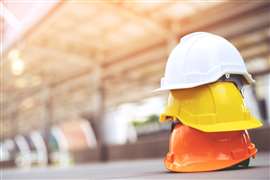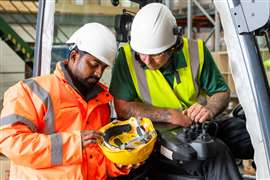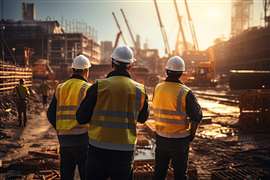Hard hats vs. safety helmets: Which is best?
04 March 2024
PPE specialist Chris Tidy weighs up the pros and cons of hard hats relative to construction safety helmets.
 Image: methaphum via AdobeStock - stock.adobe.com
Image: methaphum via AdobeStock - stock.adobe.com
News last year that the US Department of Labor’s Occupational Safety and Health Administration (OSHA) is replacing the traditional hard hats used by its employees with safety helmets ended up being one of constructionbriefing.com’s most-read stories of 2023.
Explaining its decision, OSHA said it wanted to ensure its employees were better protected, arguing that traditional hard hats, which date back to the 1960s, could fall off a worker’s head if they slip or trip, as well as lacking in ventilation.
It went on to recommend that safety helmets be used by people working in the construction industry.
But they have been slow to take off in the sector in most countries around the world.
PPE specialist and consultant Chris Tidy, who is founder of #hardhatawarenessweek and a product specialist for Mips, discusses some of the pros and cons of each type of head protection.
The benefits
While both hard hats and safety helmets provide crucial head protection on the job, there are some critical differences in their benefits:
Protection:
Hard hats: Traditional hard hats prioritise protection from falling objects with their sturdy, dome-shaped shells. They meet standards for impact and penetration but typically lack side impact protection unless they comply with ANSI Type 2 certification.
Safety helmets: Often modelled after climbing helmets, safety helmets are designed to offer more comprehensive protection. They may feature a thicker shell covering the entire head, including the sides and nape, providing improved side impact protection. However, they are typically lighter and less bulky than ANSI Type 2 Hard Hats.
 Image: Tony Pick Photography
Image: Tony Pick Photography
Comfort:
Hard hats: Traditional hard hats have a suspension system to adjust for fit, but their design can feel bulky and uncomfortable, especially for extended wear.
Safety helmets: Safety helmets tend to sit lower on the head and have more adjustable suspension systems, leading to a more comfortable and secure fit.
Other Factors:
Cost: Hard hats are generally cheaper than safety helmets due to their simpler design.
Durability: Both types of helmets are built to last with proper care, but safety helmets might offer slightly better long-term durability due to their thicker shells.
Standards: Both hard hats and safety helmets must meet relevant safety standards like ANSI or EN for specific hazards and industries.
What different features do they offer?
Hard hats: Basic hard hats typically lack additional features beyond the shell and suspension. Some offer attachable chin straps and face shields.
Safety helmets: Safety helmets often come with built-in chin straps, headlamps, visors, and slots for attaching earmuffs and face shields, offering greater versatility and customisation.
Hard hats and safety helmets may offer additional features beyond the minimum requirement for the type of helmet. For example, both might be fitted with a low-friction layer like the Mips safety system, intended to help reduce rotational motion to the head during certain angled impacts. Or they might have a bolstered retention system designed for better comfort and fit. In such cases, it depends more on the brand than the type of helmet.
The differing appeal of hard hats and safety helmets
For Workers:
Cost: Hard hats are generally cheaper than safety helmets, making them a more budget-friendly option for individual workers or employers looking to provide basic head protection. However, in recent years, more workers or employers have overlooked the cost aspect and invested in the higher level ANSI Type II type of head protection, often leading them to choose a safety helmet.
 Image: AI generated by Uranzaya via AdobeStock - stock.adobe.com
Image: AI generated by Uranzaya via AdobeStock - stock.adobe.com
Comfort: The safety helmet’s lower profile and more adjustable suspension systems, mean many wearers feel it is more comfortable and better secured; however, some workers find the traditional dome-shaped design of hard hats more comfortable than the lower-profile fit of safety helmets, especially in hot or humid environments.
Familiarity and tradition: In some industries, hard hats are the established norm, and workers might be more accustomed to their weight and feel. Changing to safety helmets could require an adjustment period for some. Still, assessing if better protection would be beneficial considering the hazards on the specific work site is important.
Perceived breathability: The open suspension system of hard hats can feel cooler and more breathable compared to the enclosed shell of some safety helmets. The emphasis is on the ‘some’, as not all safety helmets are liner-based.
For Employers:
Lower initial investment: Equipping an entire workforce with hard hats can be cheaper upfront than safety helmets, but that may compromise their safety.
Simpler logistics: Hard hats can require less maintenance and storage space than safety helmets with additional features like built-in visors or headlamps.
Compliance with basic safety standards: For workplaces with minimal overhead hazards, hard hats might be sufficient to meet basic safety regulations, reducing the need to upgrade safety helmets.
Worker acceptance: Depending on the work culture and workers’ preferences, employers might choose hard hats to avoid potential resistance to switching to a different type of head protection. However, if, after evaluating the risks at the worksite, it has been concluded that a change from a hard hat to a safety helmet is necessary, the employer should explain why the change is necessary to get buy-in from the wearers.
Is one more suited to certain types of work than the other?
It is important to know and understand the standards and assess the risk.
Most of the current hype is based on the differences between ANSI Type 1 certified hard hats and EN12492 certified safety helmets, but ANSI Type 1 certified hard hats’ direct comparison is EN397. These standards only test and, therefore, can only give protection against crown impacts or penetration; the helmets are tested by a hemispherical striker being dropped on top of the helmet in an impact absorption test. ANSI Type 1 testing has slightly better force transmission levels than its European equivalent, EN397. Still, unfortunately, this testing is not very relevant as it does not take into account our necks, which are flexible, and instead, it tests on a fixed neck headform. The result is that the value may not be relevant or true.
 Image: AI generated by Chanwit via AdobeStock - stock.adobe.com
Image: AI generated by Chanwit via AdobeStock - stock.adobe.com
It is also worth noting that none of these standards test for rotational kinematics and instead focus on linear impacts, again installing doubt that the testing methods are relevant according to current incidents/accidents that occur across all industries. Also, please note that if a helmet is fully certified to EN12492, it will not be electrically safe. EN12492 demands that the safety helmet has ventilation to comply with the standard. Those helmets on the market that are certified to EN12492 but have no ventilation will only partially meet the requirement, so please be careful when assessing the electrical risk.
ANSI Type 2 is more closely related to EN12492 in testing, although ANSI Type 2 takes it a few steps further and ultimately is more equal to another lesser-known European standard called EN14052 (High-Performance Industrial Helmets). The trend is for wearers to move from ANSI Type 1 to Type 2, but wearing slightly heavier and hotter hard hats, even though they give you better protection, can introduce non-compliance. Therefore, a proper risk evaluation should drive the change. Please also consider that you have protection from linear impacts and angled or oblique impacts.
EN397 has recently been updated to consider some of these factors. The new standard should better reflect the incidents/accidents that occur to help keep us safer. The new standard records and reflects the need for rotational kinematics testing but also considers weight and comfort, giving the wearer better protection but understanding that comfort levels need to be taken into account due to global warming.
However, it is important to remember that the potential downsides of hard hats, such as limited protection and comfort, could outweigh their advantages in the long run. Evaluating the specific workplace hazards and considering the long-term benefits of comprehensive head protection is crucial before deciding.
Ultimately, the choice between hard hats and safety helmets should be based on a risk assessment of the work environment and a commitment to prioritising worker safety and well-being.
Brought To You By
|
STAY CONNECTED



Receive the information you need when you need it through our world-leading magazines, newsletters and daily briefings.
CONNECT WITH THE TEAM








